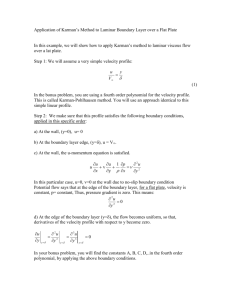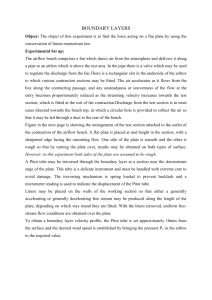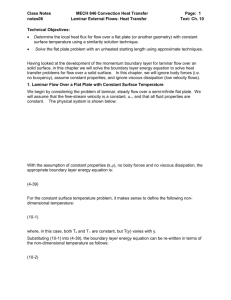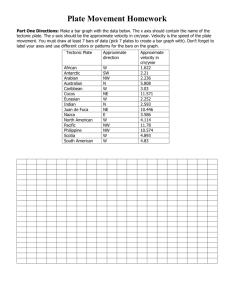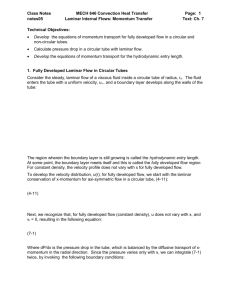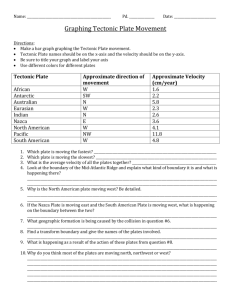notes07.doc
advertisement
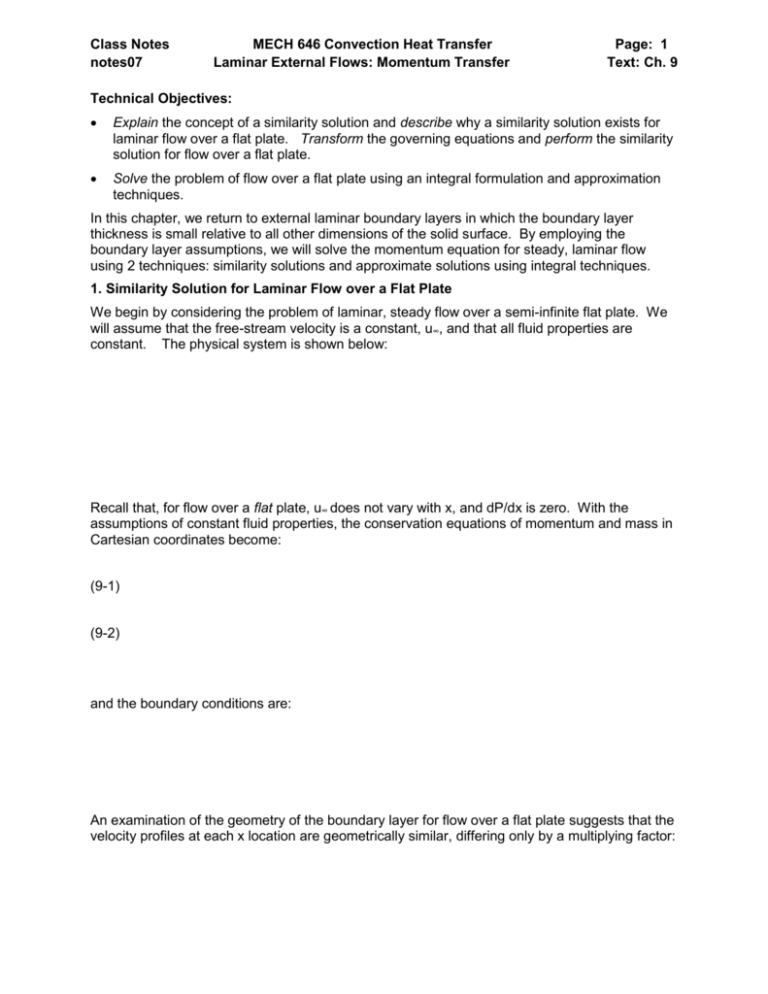
Class Notes notes07 MECH 646 Convection Heat Transfer Laminar External Flows: Momentum Transfer Page: 1 Text: Ch. 9 Technical Objectives: Explain the concept of a similarity solution and describe why a similarity solution exists for laminar flow over a flat plate. Transform the governing equations and perform the similarity solution for flow over a flat plate. Solve the problem of flow over a flat plate using an integral formulation and approximation techniques. In this chapter, we return to external laminar boundary layers in which the boundary layer thickness is small relative to all other dimensions of the solid surface. By employing the boundary layer assumptions, we will solve the momentum equation for steady, laminar flow using 2 techniques: similarity solutions and approximate solutions using integral techniques. 1. Similarity Solution for Laminar Flow over a Flat Plate We begin by considering the problem of laminar, steady flow over a semi-infinite flat plate. We will assume that the free-stream velocity is a constant, u∞, and that all fluid properties are constant. The physical system is shown below: Recall that, for flow over a flat plate, u∞ does not vary with x, and dP/dx is zero. With the assumptions of constant fluid properties, the conservation equations of momentum and mass in Cartesian coordinates become: (9-1) (9-2) and the boundary conditions are: An examination of the geometry of the boundary layer for flow over a flat plate suggests that the velocity profiles at each x location are geometrically similar, differing only by a multiplying factor: Class Notes notes07 MECH 646 Convection Heat Transfer Laminar External Flows: Momentum Transfer Page: 2 Text: Ch. 9 Recognizing the geometric similarity of the velocity profiles at all x locations, we seek a solution of the velocity profile of the following form: (9-3) where g(x) can be thought of as a “stretching factor”, which stretches out the y-coordinate of the boundary layer as a function of x. So, although, we don’t yet know what this “stretch factor”, g(x), we can define a new coordinate , which is equal to yg(x): (9-4) and, in terms of this new coordinate system, the velocity profile varies only with : (9-5) Next, we can evaluate all of the derivatives in (9-1), for the case of u = f() and = yg(x): Substituting these derivatives into (9-1) and (9-2) yields: (9-1a) (9-2a) Class Notes notes07 MECH 646 Convection Heat Transfer Laminar External Flows: Momentum Transfer Page: 3 Text: Ch. 9 It can be shown that v can be eliminated from equations (9-1a) and (9-2a), resulting in the following differential equation: (9-6) where f’ denotes df/d and g’ denotes dg/dx. Since the left hand side of (9-6) is a function only of and the right side is a function only of x, then each side must be equal to a constant, resulting in 2 ordinary differential equations: (9-6a) (9-6b) Integrating (9-6a), we obtain: Now, recalling the definition of g(x) as a stretching factor, and noting that u(0,y) = u ∞requires that g(0) →∞, which results in C = 0: Solving for g(x), we obtain: (9-7) Class Notes notes07 MECH 646 Convection Heat Transfer Laminar External Flows: Momentum Transfer Page: 4 Text: Ch. 9 This result gives us the final form of the coordinate transformation, : (9-7a) And, since we sought a solution for u = u(), this requires that: (9-7b) Returning now to the left hand side of equation (9-6), we can integrate it: The boundary conditions at y= 0: result in C = 0. (9-6c) To eliminate the integral from the above equation, we define a new function, such that: Substituting into (9-6c) yields the following differential equation for (9-6d) Class Notes notes07 MECH 646 Convection Heat Transfer Laminar External Flows: Momentum Transfer Page: 5 Text: Ch. 9 And, since k is an arbitrary constant we can set ku∞ = ½, resulting in the following differential equation, which is called the Blasius Equation: (9-8) where: which is a non-linear, ordinary differential equation for , which can be solved subject to the following boundary conditions: The Blasius Equation (9-8) was first solved numerically by Blasius in 1908. Results to the Blasius Equation are tabulated in Table 9.1 and plotted below. and ' 1.6 and '() 1.4 1.2 1 0.8 0.6 ' 0.4 0.2 0 0 0.5 1 1.5 2 2.5 3 3.5 Class Notes notes07 MECH 646 Convection Heat Transfer Laminar External Flows: Momentum Transfer Page: 6 Text: Ch. 9 Recalling the definition of ’, this provides our velocity profiles everywhere in the boundary layer over the flat plate: The surface shear stress can also be evaluated: But, as shown in Table 9.1, the solution of z’’(0) is already known, so the surface shear stress is: Recalling the definition of local friction coefficient as: (9-12) Results in the following solution for friction coefficient for flow over a flat plate: Class Notes notes07 MECH 646 Convection Heat Transfer Laminar External Flows: Momentum Transfer Page: 7 Text: Ch. 9 (9-13) Where Rex is defined as: (9-14) Note that (9-13) is the local friction coefficient. The mean friction coefficient can be evaluated as follows: (9-16) Example 9.1. Air at 300 K and 1 atm flows over a 1 m long flat plate at 10 m/s. Plot the velocity, u(y) at x = 0.125, 0.5 and 1 m. Calculate the drag on the plate in lbf if the plate were 1 m wide. Class Notes notes07 MECH 646 Convection Heat Transfer Laminar External Flows: Momentum Transfer Page: 8 Text: Ch. 9 2. Similarity Solution for Laminar External Flow with u∞(x) = Cxm Similarity solutions also exist for laminar external flow over bodies in which the local free stream velocity varies along the surface with x in the following manner: (9-20) Examples of flows wherein the velocity varies along the surface in this manner include the following. Stagnation Flow Flow Over a Wedge Note that the previous flat pate solution and the above stagnation flow is part of the same family of wedge flows, but with = 0 and = , respectively. It can be shown from potential flow theory that the free stream velocity, u∞(x), varies according to: (9-21) Recall, also that from potential flow theory, that the local pressure gradient dP/dx, is related to the gradient in the free stream velocity from equation (5-3): (5-3) (9-22a) For constant properties, along with the boundary layer assumptions, the x-momentum equation (4-10) can be reformulated as follows: (9-22) Class Notes notes07 MECH 646 Convection Heat Transfer Laminar External Flows: Momentum Transfer Page: 9 Text: Ch. 9 Substituting in dP/dx from (9-22a) into the momentum equation (9-22) results in: (9-23) This equation can also be solved using the same similarity solution technique that was used for the flat plate. In this case, the transformed differential equation is: (9-24) Which can also be solved numerically. Table 9-2 shows the solutions for ”(0) for various wedge angles, . Recall that ”(0) is by definition related to (du/dy)s and is therefore related to the surface shear stress and, therefore, the friction coefficient as follows: (9-25) Class Notes notes07 MECH 646 Convection Heat Transfer Laminar External Flows: Momentum Transfer Page: 10 Text: Ch. 9 3. Approximate Solution for Flow Over a Flat Plate We now return to the problem of flow over a flat plate to illustrate the power of the momentum integral techniques developed in Chapter 5 in developing approximate boundary layer solutions. Recall that the boundary layer integral equation reduced to the following for flow over a flat plate (dP/dx = 0): (5-9) Where 2 was defined as the momentum thickness. And, since s is equal to (du/dy)s, then equation (5-9) becomes: (9-31) Recall that the integral formulations themselves were not approximate but they are used to develop approximate solutions because we can solve them by assuming a form of the velocity profile u(y). Moreover, since the results are often not highly dependent on the assumed shape of the velocity profile, these techniques are quite useful. So, the question is, what is the best assumption for the shape of the velocity profile? An examination of equation (9-1) gives us a clue as to what might work well. Since u and v must both go to zero at the surface, equation (9-1) suggests that the second derivative of u with respect to y must also go to zero: So, since d2u/dy2 must go to zero at the surface, this suggests that a cubic equation of the following form might work well: Class Notes notes07 MECH 646 Convection Heat Transfer Laminar External Flows: Momentum Transfer Page: 11 Text: Ch. 9 By imposing the following boundary conditions for the above velocity profile: We end up with the following approximate velocity profile for velocity in the boundary layer for flow over a flat plate: (9-32) Substituting the velocity profile (9-32) into the momentum integral equation (9-31): (9-33a) Class Notes notes07 MECH 646 Convection Heat Transfer Laminar External Flows: Momentum Transfer Page: 12 Text: Ch. 9 So, equation (9-33a) is a simple ordinary differential equation that can be solved for the boundary layer thickness as a function of x, given the boundary condition of = 0 at x = 0. (9-33) Equation (9-33) provides an approximate solution for the boundary layer thickness as a function of x, for flow over a flat plate. Note that (9-33) cannot be directly compared with the exact solution. Why not? Equation (9-33) can, however, be used to evaluate the surface shear stress: (9-34a) And, finally, a friction coefficient can be defined for direct comparison with the Blasius solution: (9-34) This result is within 3% of the exact Blasius solution of Cf = 0.664/Rex1/2. Class Notes notes07 MECH 646 Convection Heat Transfer Laminar External Flows: Momentum Transfer Page: 13 Text: Ch. 9 Example 9.2. Air at 300 K and 1 atm flows over a 1 m long flat plate at 10 m/s. Using the approximate solution, plot the velocity, u(y) at x = 0.125, 0.5 and 1 m and compare the results to the exact solution. Plot the approximate boundary layer thickness as a function of x for a free stream velocity of 10 m/s and 100 m/s. Calculate the drag on the plate in lbf if the plate were 1 m wide and compare to the exact solution. HW: 9-1, 9-3
